Throughout history, humans have been fascinated by the wonders of the night sky, using celestial objects as guides for navigation and timekeeping. Early farmers and herders recognized the need for a calendar to ensure consistent and timely agricultural practices. Through careful observation of the Sun and the Moon, ancient astronomers noticed the repetitive patterns and unique movements of these celestial bodies, leading to the identification of the constellation through which the ecliptic passes.
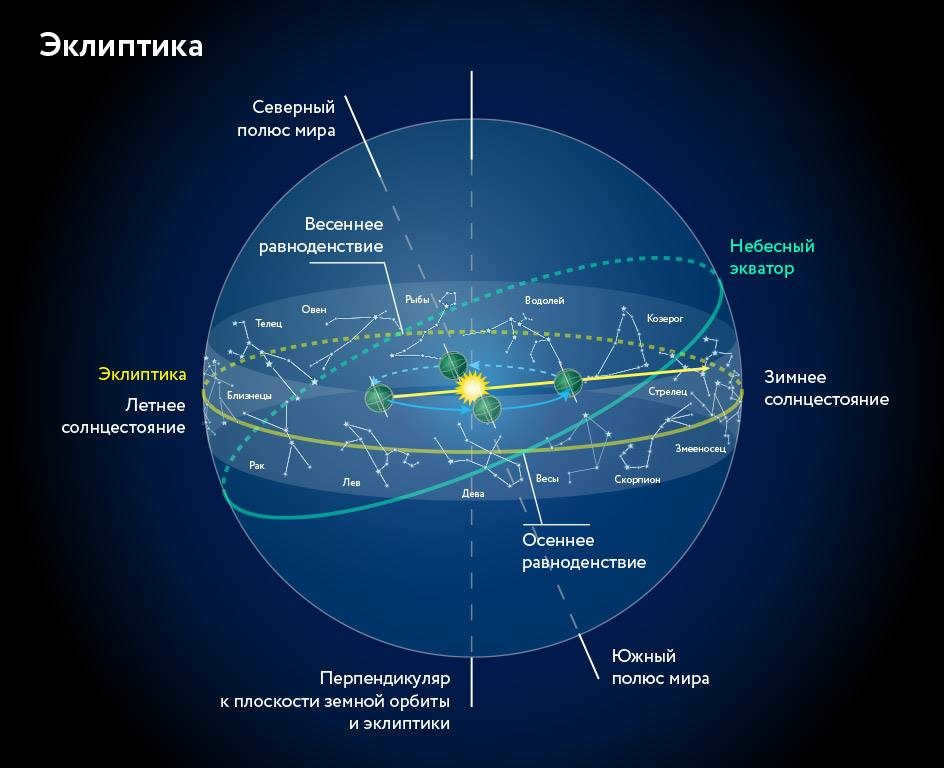
Definition and significance
An essential element in comprehending the workings of the solar system is known as the ecliptic. In the case of Earth, the planet’s ecliptic refers to an imaginary plane defined by its one-year orbit. In simpler terms, it encompasses the entire plane between Earth and the Sun, encompassing a complete orbit around the star.
The concept of the “ecliptic” also applies to the Sun itself, representing the plane formed by the star’s movement through outer space as it passes through the 12 constellations. It is worth noting that the ecliptic plane of the Sun aligns with the ecliptic planes of all the planets in the Solar System.
Ancient civilizations utilized observations of the Sun’s movement in the field of agriculture. Typically, they settled near major rivers like the Yangtze, Euphrates, Nile, and others. These people recognized that not only did climatic conditions alter with the changing seasons, but also the Sun’s position in the sky. During this time, they observed a deviation in the trajectory of the Sun, which occurred approximately once every 365 days – a yearly cycle.
Antiquity’s scientists made note of the Sun’s movement along two paths. The first path was a daily one, moving from east to west, while the second path projected onto the celestial sphere, giving rise to the concept of the “ecliptic”.
The tilt of the Earth, which is 23 degrees 51 minutes, was first calculated by the explorer-astronomer Eratosthenes in the third century B.C. This tilt angle is always maintained by the Earth, regardless of its orbital motion or the changing seasons.
Coordinates
In modern astronomy, the circle of the ecliptic is used as the primary coordinate system for the motion of the Earth and the Sun. In this coordinate system, latitude is measured by the distance from the south to north pole of the ecliptic, while longitude is measured from west to east. The pole of the ecliptic is the point where the plane intersects the perpendicular.
The equator divides the entire ecliptic plane into two equal parts. The opposite points of the equator are known as nodes or equinoxes. The points of the winter and summer solstices are located in the middle of the orbital path between the equinoxes.
The equinox line, also known as the celestial equator, is a fictional plane that is positioned at a right angle to the Earth’s axis of rotation. All satellites that orbit near our planet are positioned within this specific plane. When examining a star chart, the line that extends horizontally from west to east represents the equator.
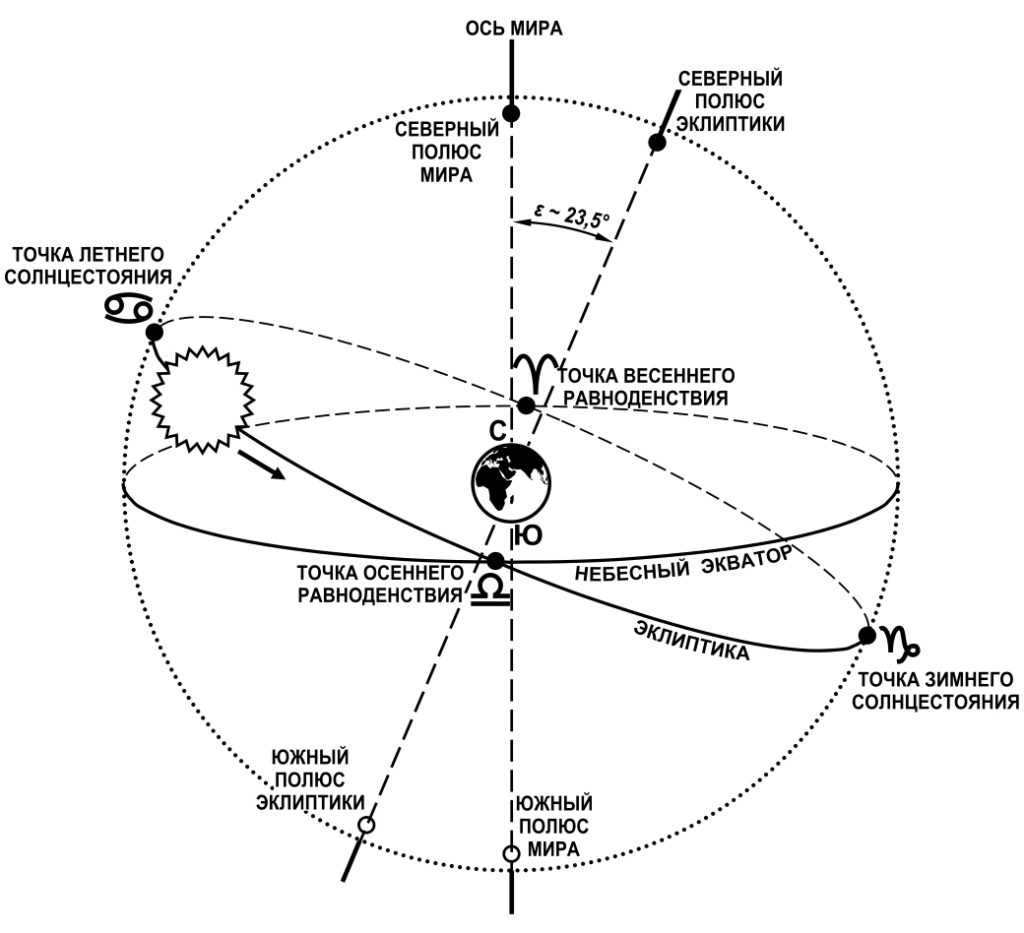
The equator in the ecliptic concept is also known as the line of parity. This designation was bestowed for a specific reason, as the stars situated in this region spend an equal amount of time above and below the horizon. The same phenomenon is observed with the Sun, occurring twice a year during the equinoxes.
The celestial equator aligns with the ecliptic plane and forms an angle of 23º 27′. This angle represents the inclination of the ecliptic. This value has remained constant for millions of years. However, researchers have determined that it decreases by 48″ every century. This process of diminishing the angle will persist for several thousand more years until it reaches its minimum position of 22° 54′.
Only at 47° of the Earth’s surface, the rays of the sun fall directly downwards. This occurs because of the spherical shape and tilt of the Earth. The Tropic of Cancer marks the northernmost latitude where sunlight falls perpendicularly, at 23º 27′. Similarly, the Tropic of Capricorn marks the southernmost latitude with the same occurrence, also at 23º 27′. These latitudes represent the extremes of an imaginary line along which the Sun travels throughout the year. When the Sun is directly above these points, it is known as a solstice. During solstices, the longest daylight hours and shortest nights are observed.
The names of the points were derived from the names of the constellations: Capricorn in the southern hemisphere and Cancer in the northern hemisphere. The points where the ecliptic and celestial equator intersect align with the constellation of Pisces in the spring and the constellation of Virgo in the fall. It is at these points that the Earth experiences even illumination, known as the equinoxes, when the length of the night matches the length of the daylight hours. As the Earth completes its orbit around the Sun over the course of a year, the equinoxes occur on September 21 and March 21.
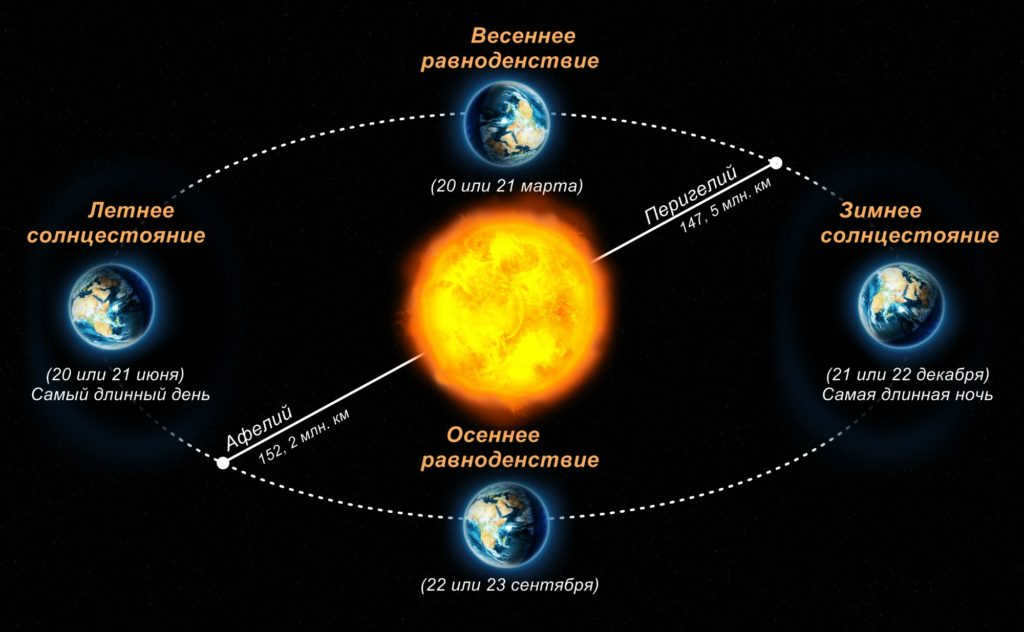
The occurrence of equinoxes changes over time. Scientists have discovered that the moment of equinoxes now happens 20 minutes and 24 seconds earlier compared to the previous sidereal year. This is a recurring phenomenon that repeats every 25,776 years. In the field of celestial mechanics, there is a slight shift in the equinoxes, although they ultimately return to their original positions.
Origin of the orbital plane
The arrangement of the Sun and all the planets in the same plane is not a coincidence, but rather a result of the processes involved in the formation of our solar system.
Scientific research has revealed that our central star, the Sun, came into existence through the accumulation and compression of interstellar matter, such as gas and dust, that was left behind by previous generations of stars. As this matter began to rotate, centrifugal forces caused it to form a large disk, which then pushed material away from the central axis of rotation.
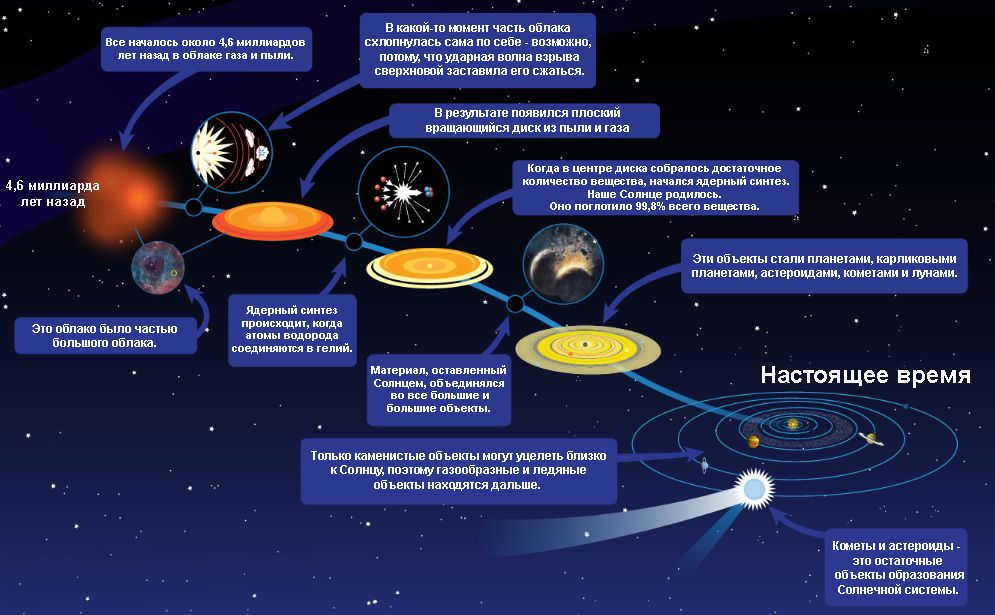
Unstable rotation caused by gravitational, hydrodynamic, and magnetic processes leads to the accumulation of a significant amount of matter in the center of the disk. This rapid increase in material eventually reaches a critical mass, resulting in gravitational collapse and the initiation of thermonuclear processes.
Once thermonuclear reactions begin, the protostar emits radiation into space. Photon pulses and the solar wind then reshape the protoplanetary gas-dust disk that remains after the formation of the Sun. The combined effects of gravity and radiation pressure cause matter to disperse and merge, forming larger fractions that eventually coalesce into planets, satellites, comets, and asteroids. These celestial bodies continue to gather additional material as they orbit.
The arrangement of all objects in the Solar System on a single plane can be attributed to their formation from the primary disk of matter situated on the same plane.
The journey of the Sun through the constellations of the zodiac
Throughout the entire ecliptic, there are 13 constellations that the Sun traverses in its yearly journey. These constellations have been named after animals since ancient times.
Feel free to explore the table below, which showcases all the constellations that intersect the ecliptic.
| № | Name: Russian/Latin | Dates of the Sun’s stay in the constellation | Time of the Sun’s passage through the constellation in days |
| 1 | Aries/Aries | April 19 to May 13 | 25 |
| 2 | Taurus/Taurus | May 14 through June 19 | 37 |
| 3 | Gemini/Gemini | June 20 to July 20 | 31 |
| 4 | Cancer/Cancer | July 21 through August 9 | 21 |
| 5 | Leo/Leo | August 10 through September 15 | 37 |
| 6 | Virgo/Virgo | September 16 through October 30 | 45 |
| 7 | Libra/Libra | October 31 through November 22 | 23 |
| 8 | Scorpio/Scorpius | November 23 through November 29 | 7 |
| 9 | Serpentine/Ophiuchus | November 30 through December 17 | 18 |
| 10 | Sagittarius/Sagittarius | December 18 through January 19 | 32 |
| 11 | Capricornus | January 20 through February 15 | 28 |
| 12 | Aquarius/Aquarius | February 16 through March 11 | 24 |
| 13 | Pisces/Pisces | March 12 through April 18 | 38 |
Ecliptic of the planets in the Solar System, the Moon, and other celestial objects
While we have a solid understanding of the Earth’s angle and its orbit, the exploration of other planets remains a top priority and captivating field in modern astronomy. Research has revealed that all planets in the Solar System, with the exception of dwarf planets, orbit in a similar plane with slight variations. Allow us to introduce you to the variations in the rotation angles of the planets in relation to the ecliptic.
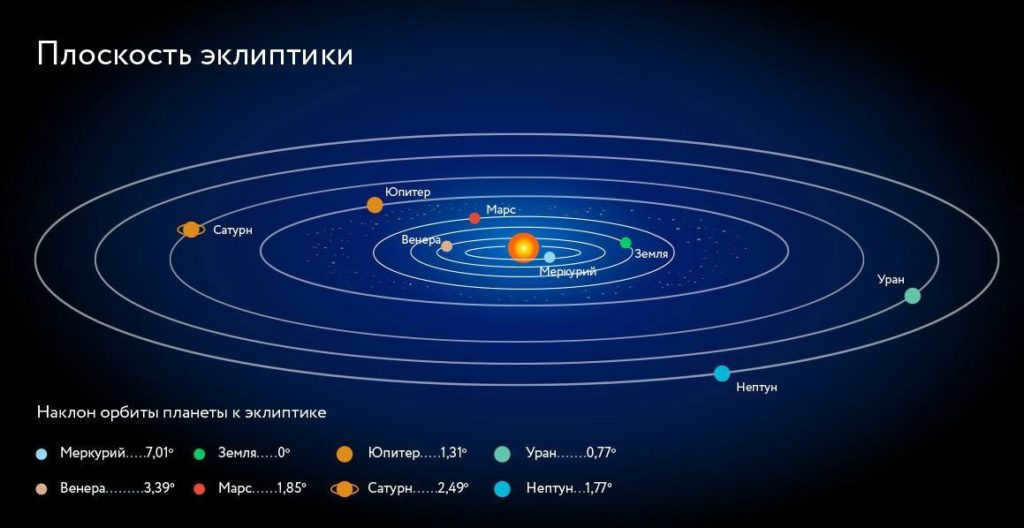
It is evident from the data presented in the table that Mercury exhibits the greatest deviation from the overall plane of rotation. In contrast, the gas giants, with the exception of Saturn, align closely with the ecliptic plane. However, when considering low-mass celestial bodies like dwarf planets, asteroids, and comets, their orbits can vary significantly from the norm. For instance, the dwarf planet Erida possesses an extremely elongated orbit and may even come closer to the Sun than Pluto. Consequently, it is inclined at an angle of 45 degrees to the ecliptic plane.
Ecliptic Path in the Sky
In order to track the ecliptic path in the sky, one must understand that it is the route that is taken by the Moon, Sun, and other planets when viewed from the Earth. This imaginary line can be best visualized on a clear night sky before the full moon.
To accomplish this, the observer should be positioned in an open area after the sun has set. It is crucial that the sky is free from clouds and clear, as this will enable the identification of the ecliptic line by focusing on the following characteristics.
- Directly above the sunset point of the Sun, a brilliantly illuminated Venus can be observed.
- The Moon will be positioned just above the eastern horizon.
- A third point of observation could be Mars, which will be slightly higher than the Moon.
- About two hours after sunset, a fourth point, Saturn, will become visible in the eastern direction.
By connecting all these points with an imaginary line, we can trace the path of the ecliptic. It is worth noting that although these celestial bodies are not perfectly aligned, their orbits are nearly in the same plane as the Earth. Due to this slight deviation, solar eclipses do not happen on a monthly basis.
Ecliptic in literature
Even in works of literature, references to the ecliptic can be found. For instance, in the series of stories “About Pilot Pirx,” author Stanislav Lem incorporates this astronomical term. In this work, all spaceships are prohibited from venturing into the ecliptic plane. However, the protagonist, Pilot Pirx, is required to cross the ecliptic in the course of his duties. It is during one such journey that he stumbles upon a massive abandoned alien vessel that arrived alongside a meteor shower.
In the vast expanse of the universe, various types of stars exist, including the ecliptic constellations. These constellations are situated within a region of space known as the Ecliptic. Like the constellations visible in the northern and southern hemispheres, these cosmic formations consist of large collections of stars.
As we mentioned in Journey into Space, every constellation is categorized based on its position in space. Consequently, the ecliptic constellations are situated along the ecliptic. This specific position refers to an imaginary line that seems to intersect with the Sun’s yearly trajectory as observed from Earth. We can refer to this trajectory as the Sun’s Path.
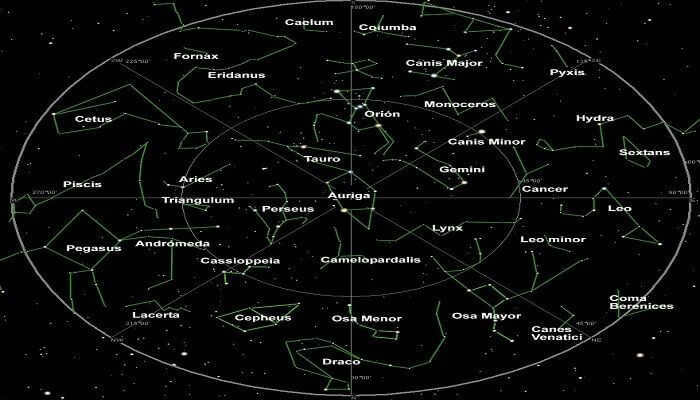
Nevertheless, the identification of these particular constellations is not based on their location. The primary reason behind their designation as the ecliptic constellations is because they form a circular path. An interesting fact about the ecliptic is that it serves as the pathway for solar and lunar eclipses. In essence, the term “ecliptic” is derived from the word “eclipse.”
2- The primary characteristics of ecliptic constellations
Characteristic 1: They consist of star clusters
Constellations, as we are familiar with, are traditional groupings of stars. The placement of these constellations in the night sky appears to be unchanging. An interesting aspect of their history is that ancient civilizations decided to link these constellations together with imaginary lines. This imaginative endeavor from ancient times resulted in the formation of virtual shapes on the celestial sphere.
Within the vastness of the universe, the stars comprising the constellations are not necessarily spatially connected. Despite the fact that these constellations may be hundreds of light years apart. Conversely, these clusters of stars are entirely subjective, as various cultures have devised their own unique constellations, sometimes even associating the same stars.
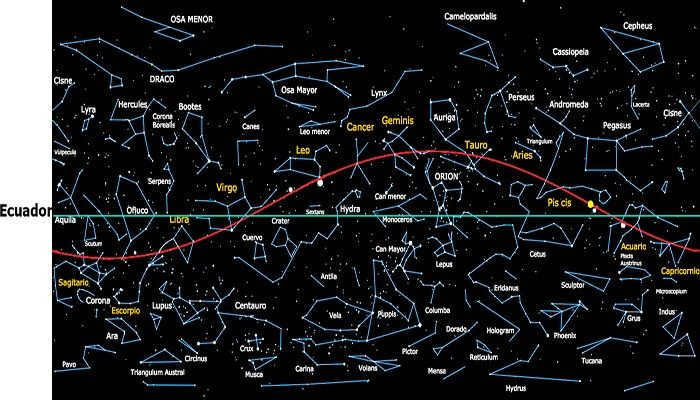
If we specifically discuss the constellations along the ecliptic, we are primarily highlighting that the ecliptic represents the major circle of the constellation. The celestial sphere. This circle intersects the equator at the tropics, precisely at 23º 27' latitude north or south. It is worth mentioning that the circle forming the ecliptic is divided into 360 degrees, as the ancient people roughly estimated that the Sun could move one degree each day.
Specifically, it is elaborated that the ecliptic corresponds to two measurements of the solar disk or the moon. In this regard, the ancients assigned 360 full revolutions to them, which is why the circle is divided into 360 degrees, roughly equivalent to one day per year.
Ecliptic
The term ecliptic is used to describe the representation of the Earth’s orbital plane on the celestial sphere. Alternatively, it can also be used to define the observable path that the Sun follows throughout the year as it passes through the twelve well-known constellations of the Zodiac. This refers to the distinct arrangement of the constellations along the ecliptic.
The angle of inclination of the ecliptic is the same as the angle at which the Earth’s orbit is inclined to the celestial equator, which is approximately 23.5 degrees. It is important to mention that the ancient people referred to the path where eclipses take place. This path aligns with the orbital plane of the Earth around the Sun, which is almost identical to the orbital planes of other planets and the rotational plane of the Moon around the Earth.
Characteristic 2: Associated with other celestial entities.
The zodiac is a fundamental celestial configuration used to determine the positions of the constellations along the ecliptic. Understanding the zodiac is crucial as it serves as the intersection point of the ecliptic. The zodiac, also known as the Zodiaco, is a band that encircles the celestial sphere, spanning approximately 8 and a half degrees on both the northern and southern sides of the ecliptic. It follows a path slightly above or below the Sun’s trajectory.
Astronomy and astrology can be quite perplexing. Although they both explore the movements and characteristics of celestial bodies, their purposes differ greatly. Astronomy is a scientific discipline, focused on understanding the universe, while astrology delves into the belief that celestial bodies influence human destiny. In fact, astrologers are the ones who question the notion of predetermined fate. Many scientists who are also theists oppose astrology since they acknowledge the existence of a higher power and appreciate the importance of patiently allowing events to unfold in accordance with divine will.
To specifically elucidate the objections of these theistic scientists, let’s consider astrology, a field of study that examines the positions and movements of celestial bodies. The findings of astrology are then interpreted to uncover the fates of individuals and forecast potential events on our planet. It’s important to distinguish astrology from astronomy, which is a scientific discipline focused on investigating the structure, composition, location, and motion laws of celestial objects.
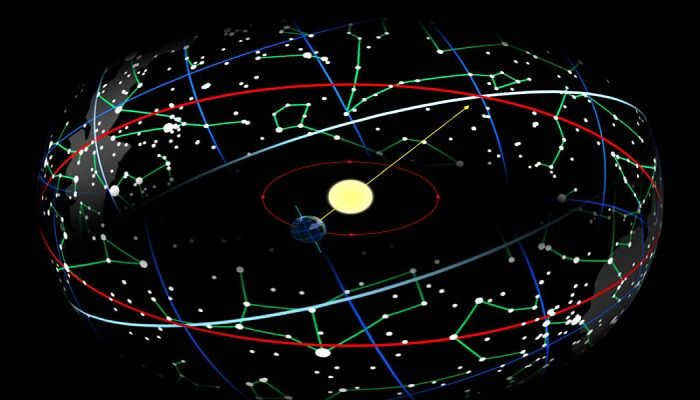
It is crucial to highlight this point because, as individuals who seek knowledge about the universe, we must rely on scientific inquiry. Those who have faith in and trust astronomy understand that the Zodiac is simply a grouping of various constellations. The concept of the Zodiac is often overlooked. It is remarkable that everything in the universe is created by a higher power, as expressed by the esteemed physicist Albert Einstein when he said, “I am filled with nothing but admiration when I contemplate the laws of nature. There can be no laws without a Lawgiver.”
The term Lawgiver in this context pertains to the divine entity, God. Thus, it can be understood that the motions across the Zodiac are also governed by the Lawgiver, who is also associated with the renowned figure, Einstein. In other words, God. Naturally, this encompasses clusters of stationary stars that may seem proximate to each other and shape recognizable patterns, such as the constellations along the Ecliptic. Familiarity with this subject matter is essential in order to locate and differentiate various stars in the expansive celestial sphere.
The ecliptic is the path of the Sun in the celestial sphere, as mentioned before. It is bounded by a range of eight-degree arcs on either side, forming the conditional limit of the zodiac. However, the zodiac is traditionally divided into twelve constellations, which has caused some controversy.
Interestingly, the ecliptic actually passes through thirteen constellations in the sky. However, one of them, the Serpentine (Serpent), is not considered part of the zodiac in astrology. The constellations recognized in the astronomical zodiac include Aries, Taurus, Gemini, Cancer, Leo, Virgo, Libra, Scorpio, Serpent (Serpentine), Sagittarius, Capricorn, Aquarius, and Pisces. These are the constellations through which the Ecliptic Constellations traverse.
This article adheres to our editorial ethics guidelines. If you find any errors, please click here to report them.
Access the full article here: postpost “Constelaciones” 2. Key Features of the Ecliptic Constellations.


Currently, 58,742 educational institutions have access to additional cumulative discounts ranging from 2% to 25%. To determine the discount applicable to all staff members of your educational institution, please sign in to your personal Infoworks account.


Course for professional growth
Management of dangerous waste belonging to hazard classes I – IV
We can apply a discount from your educational institution to this offer (the amount depends on the number of your colleagues who have already completed courses with Infoworks).
Currently, 58,742 educational institutions are eligible for additional discounts (ranging from 2% to 25%). To find out the exact discount applicable to all employees of your educational institution, please login to your personal Infoworks account.


Course for professional growth
Enhancing the safety of an educational institution through media development
We can include your educational organization’s discount along with this offer (the amount depends on the number of your colleagues who have completed Infoworks courses)
At present, 58,742 educational institutions are eligible for additional discounts (ranging from 2% to 25%). To determine the discount applicable to all staff members of your educational institution, please log in to your personal Infoworks account.


Techniques for Achieving a Goal
Selected Document: dictation.docx
g) Dictation [on your PCZN] [10-12 minutes.]
- What is the Sun’s declination on the summer solstice (June 22) [23 o 26′]
- What is the Sun’s declination on the autumnal equinox (September 23) [0 o ]
- What constellations are known as zodiacal constellations? [those through which the ecliptic passes]
- Which constellation is the Sun in today? [according to PCZN-Devas]
- Today, the Sun’s declination is >O or
- What is the latitude of the Kolybelyka village if hр=54 o 04' [φ=hр=54 о 04']
- How does the daily movement of the stars appear to an observer at the North Pole of the Earth? [parallel to the horizon]
- Do the stars at Earth’s North Pole reach their highest point in the sky? [yes, but hВ= hн]
- Which formula can be used to calculate the height of the Sun at noon? [ h=90 o – φ+δ].
- List the constellations that the celestial equator passes through: a) Pisces, Whale, Taurus (border), Orion, Unicorn, Hydra, Sextant, Leo, Virgo, Snake, Serpent, Serpentine, Eagle, Aquarius b) Scorpio, Sagittarius, Shield, Snake, Eagle, Arrow, Fox, Swan, Cassiopeia, Perseus, Ascendant, Orion, Unicorn, Corma)
- In Novosibirsk, with a latitude of 55°, the star culminates at an altitude of 45°. What is the declination of the star? (The declination is calculated as 90° – latitude + δ, where δ is 10°).
- The star culminates to the south at 15° and has a declination of 45°. What is the geographic latitude of the place of observation? (The latitude is calculated as δ + Z, where Z is 60°).
- Earth is closest to the Sun on January 4. In which constellation is the Sun at this time? (The Sun is in Sagittarius).
- The luminary culminates south, or north of the zenith, if δ
- Calculate the noon altitude of the Sun today in the village of Kolibelka, with a latitude of 54°. (The altitude is calculated as 90° – latitude + δ, where δ is approximately -2°).
ADDITIONAL (to expand, or substitute assignments):
- At what time will the star a Lyra rise above the horizon on April 12? (According to the PCZN, it will rise around 6 p.m.).
- Find out the exact time when the star a Cassiopeia reaches its lowest point in the sky on March 21st. (according to SCZN, approximately at 0:40 AM)
- When will the star Rigel reach its lower culmination today? (according to the SCZN, for example, at 4:30 PM on October 3rd)
- Discover the constellation under which you were born, meaning the constellation in which the Sun was positioned on your birthday. To do this, draw a line connecting the celestial pole and your birth date, and observe the point where this line intersects the ecliptic. Why does this result differ from what is indicated in horoscopes?
- What time did the Sun rise and set today? Determine the duration of the day. (according to PCZN, for example, sunrise at 7:30 AM, sunset at 7:00 PM, duration of 11 hours and 30 minutes)
- A group of students from a school went on a hiking trip towards the southeast. In what direction should they return? (northwest)
Document chosen for viewing SCZN assignments.docx
Task ELSI (during the presentation of new material)
1.) identifying the celestial equator, ecliptic, equatorial coordinates, equinox, and solstice points.
2) determining the coordinates of stars such as Capella (α Ascendant), Deneb (α Swan).
3) finding stars by coordinates: (α=14.2 h, δ=20 o )
4) determining the current location of the Sun, and in which constellations it can be found during autumn.
5) A satellite traveled across the sky from its initial coordinates (α=18 h 15 m, δ=36 o ) to its final coordinates (α=22 h 45 m, δ=36 o ). Which constellations did the satellite pass through?
3) The task is to locate stars based on their coordinates: (α=14,2 h , δ=20 o )
4) Determine the current position of the Sun, specifically in which constellations it is located during the autumn season.
5) A satellite traveled across the sky starting from the initial coordinates (α=18 h 15 m , δ=36 o ) and ending at the coordinates (α=22 h 45 m , δ=36 o ). Which constellations did the satellite pass through?
Work on PCCP (during the presentation of new material):
1.) Locate the celestial equator, ecliptic, equatorial coordinates, equinox, and solstice points.
2) Determine the coordinates of stars such as Capella (α Ascendant) and Deneb (α Swan).
3) The task is to locate stars based on their coordinates: (α=14,2 h , δ=20 o )
4) Determine the current position of the Sun, specifically in which constellations it is located during the autumn season.
5) A satellite traversed the sky from the starting point with coordinates (α=18 h 15 m, δ=36 o) to the destination point with coordinates (α=22 h 45 m, δ=36 o). What constellations did the satellite pass through?
Work on PCCP (during the presentation of new material):
1) Identifying the celestial equator, ecliptic, equatorial coordinates, equinox, and solstice points.
2) Determining the coordinates of stars such as Capella (α Ascendant) and Deneb (α Swan).
3) Locating stars by coordinates: (α=14.2 h, δ=20 o)
4) Finding the current position of the Sun and the constellations it is in during the fall.
5) The satellite passed through the sky from the starting point with coordinates (α=18 h 15 m, δ=36 o) to the destination point with coordinates (α=22 h 45 m, δ=36 o). What constellations did the satellite travel through?
Document selected for viewing about ecliptic.docx
c) The Sun’s yearly movement. There are celestial bodies [Moon, Sun, Planets] whose equatorial coordinates change rapidly. The ecliptic is the apparent yearly path of the center of the solar disk across the celestial sphere. It is currently inclined to the plane of the celestial equator at an angle of 23 degrees 26 minutes. The observable motion of the Sun along the ecliptic is a reflection of the actual motion of the Earth around the Sun (which was only proven in 1728 by J. Bradley with the discovery of annual aberration).
Celestial phenomena arising from these cosmic occurrences
Rotation of the Earth around its axis
Physical phenomena:
1) The eastward deflection of falling objects;
2) The presence of Coriolis forces.
Indications of the Earth’s actual rotation on its axis:
1) The daily rotation of the celestial sphere around the Earth’s axis, moving from east to west;
2) The rising and setting of celestial bodies;
3) The highest point reached by celestial bodies;
4) The transition between day and night;
5) The daily variation in the position of celestial bodies;
6) The daily change in the apparent position of celestial bodies due to the observer’s location.
The Earth’s orbital motion around the Sun
There are several ways to observe the Earth’s rotation around the Sun:
1) The apparent movement of the stars from west to east, which gives us a different view of the starry sky throughout the year;
2) The Sun’s yearly movement along the ecliptic, also from west to east;
3) The change in the Sun’s midday altitude above the horizon as the year progresses; a) The variation in daylight hours as the seasons change; b) The phenomenon of polar day and polar night in high latitudes;
5) The changing of seasons;
6) The annual aberration of the stars;
7) The annual parallax of the stars.
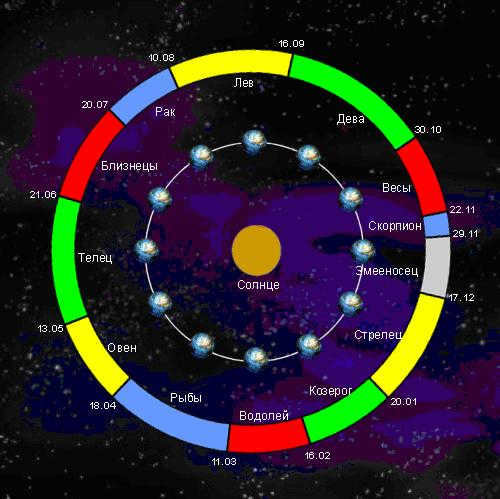
Constellations that the ecliptic passes through are known as zodiacal constellations
The zodiacal constellations consist of 12 constellations, which is the same as the number of months in a year. Each month is associated with the sign of the constellation in which the Sun is located during that month.
The 13th constellation, Serpentine, is not included in the zodiac, even though the Sun passes through it. “Red Shift 5.1” (Sun’s path).
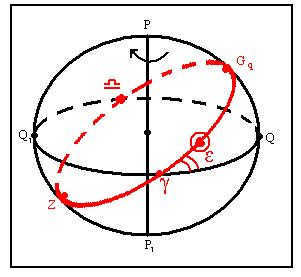
– The vernal equinox occurs on March 21 (when day and night are equal in length).
The Sun’s coordinates are: α ¤ =0 h , δ ¤ =0 о
This designation has been used since the time of Hipparchus, when this point was in the constellation of Aries. It is currently in the constellation of Pisces and will move to the constellation of Aquarius in 2602.
– The summer solstice occurs on June 22 (the longest day and shortest night of the year).
The Sun’s coordinates are: α ¤ =6 h , ¤ =+23 о 26′
This designation has been used since the time of Hipparchus, when this point was in the constellation of Gemini. It then moved to the constellation of Cancer and since 1988 has been in the constellation of Taurus.
– The day when the autumnal equinox occurs. September 23. (when day and night are equal in length).
The Sun’s coordinates: α¤=12 h, δ¤=0 о
The symbol of justice, known as the constellation Libra, was preserved under Emperor Augustus (63 BC – 14 BC). It is currently located in the constellation Virgo and will move to the constellation Leo in 2442.
– The day of the winter solstice. December 22. (the shortest day and the longest night).
The Sun’s coordinates: α¤=18 h, δ¤=-23 о 26′
During the time of Hipparchus, this point was in the constellation Capricorn. It is now in the constellation of Sagittarius and will move to the constellation of Serpentor in 2272.
Let’s select a specific star and anchor its position in the celestial dome. In precisely 24 hours, or more precisely 23 hours and 56 minutes, the star will reappear at the same spot. This time frame, known as a sidereal day, is determined by the interval between two consecutive upper culminations of the vernal equinox. To be more precise, a sidereal day is the time it takes for the Earth to complete one full rotation relative to distant stars.
But what happens to the remaining 4 minutes? Well, due to the Earth’s orbital motion around the Sun, it shifts by 1° against the backdrop of the stars each day. To compensate for this shift and “catch up” with the star, the Earth requires these additional 4 minutes. You can see this illustrated in the figure on the left.
As the nights progress, the stars gradually move to the west, rising 4 minutes earlier each subsequent night. Over the course of a year, the stars will have shifted by 24 hours, resulting in the repetition of the sky’s appearance. In fact, the entire celestial sphere completes one full revolution in a year, which is a consequence of the Earth’s revolution around the Sun.
Therefore, the Earth completes a full rotation on its axis in 23 hours and 56 minutes. The average solar day, which is the time it takes for the Earth to complete one revolution relative to the center of the Sun, is approximately 24 hours.
Selected document for viewing: APPENDIX 2 terms.docx
Selected document for viewing: appendix 2.docx

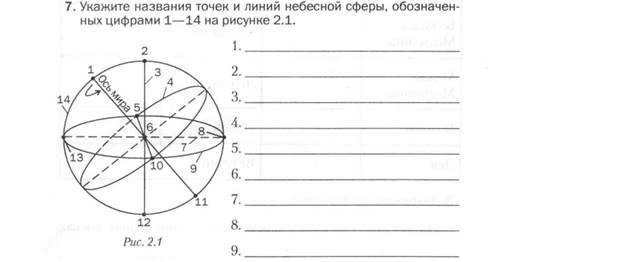






Document chosen for viewing Lesson 5 Ecliptic.docx
Lesson 5 The yearly motion of the Sun.
Personal: demonstrate willingness to embrace the history, culture, and traditions of diverse peoples.
Metacognitive Formulate conclusions regarding the factors influencing the varying lengths of day and night based on latitude; analyze the celestial view using a dynamic map that adjusts for the time of year.
Subjects Reproduce the definitions of terms and the concept of “ecliptic”, explain the apparent movement of the Sun throughout the year; describe the characteristics of the Sun’s daily movement at the poles, equator, and middle latitudes of the Earth, identify the reasons for variations in day-night duration at different latitudes throughout the year.
Exploration of the concepts “equinox days” and “solstice days” and examination of their astronomical significance. Introduction of the term “ecliptic”. Investigation into the Sun’s movement throughout the year in relation to the constellations using an interactive map. Deliberation on the length of daylight and nighttime based on the geographical latitude throughout the year.
– Utilization of the PCZN (on cards from the workbook.) See Appendix 1 for more information.
– Familiarization with key terminology. Refer to Appendix 2 for additional details.
Establishing the learning objective.
Different civilizations worshipped different celestial bodies: the ancient Egyptians revered the star Sirius, while the ancient Slavs held the Pleiades and the brightest stars of Orion’s Belt in high regard. However, the ultimate reverence was reserved for the Sun. Yarilo, Svetovid, Yarovit, and Khors were personifications of the Sun in East Slavic culture. The Moon, on the other hand, served as the opposite of the Sun. Traditional folk festivals, still celebrated today, coincide with key dates in the solar cycle, such as the equinox and solstice. This raises the question: why is the Sun not included on star charts? The answer lies in understanding the Sun’s diurnal and annual movements. We can visually represent the Sun’s different positions throughout the day and year by analyzing various diurnal parallels based on different latitudes of observation. The Earth’s rotation causes the Sun’s position relative to the horizon to change throughout the day, while its annual motion around the Sun results in the Sun’s apparent movement from our perspective on Earth.
To comprehend the astronomical significance of the equinox and solstice days, it is recommended to present students with the following tasks in groups. tasks.
1. Listen to the poem and respond to the question: which zodiacal constellations will reach their highest point in the respective month?
2. Utilizing a dynamic starry sky map, ascertain the coordinates of the Sun on June 22 and December 22. Elucidate why these days are referred to as the summer and winter solstice days.
3. Elaborate on how the duration of daylight and darkness changes from March 21 to June 22, from June 22 to September 23, from September 23 to December 22, and from December 22 to March 21.
The Sun’s yearly movement. There are celestial bodies [Moon, Sun, Planets] whose coordinates at the equator change rapidly. The ecliptic is the visible path of the center of the solar disk on the celestial sphere. The celestial sphere. Currently inclined to the plane of the celestial equator at an angle of 23 degrees 26 minutes. The Sun’s visible movement along the ecliptic reflects the actual movement of the Earth around the Sun (which was proven in 1728 by J. Bradley with the discovery of annual aberration).
Celestial phenomena resulting from these cosmic events
The Earth’s rotation around its axis
Physical phenomena:
1) the deviation of falling objects towards the east;
2) presence of Coriolis forces.
Manifestations of the actual rotation of the Earth around its axis:
1) the daily rotation of the celestial sphere around the Earth’s axis from east to west;
2) the rising and setting of the celestial bodies;
3) the culmination of the celestial bodies;
4) the alternation of day and night;
5) diurnal aberration of the celestial bodies;
6) diurnal parallax of the celestial bodies
Earth’s orbit around the Sun
There are several displays that show the Earth’s rotation around the Sun:
- The annual change in the view of the starry sky, which is the apparent movement of celestial luminaries from west to east.
- The annual movement of the Sun along the ecliptic, which is from west to east.
- The change in the midday altitude of the Sun above the horizon throughout the year.
- The change in the length of daylight hours during the year.
- The phenomenon of polar day and polar night at high latitudes of the planet.
- The change of seasons.
- The annual aberration of the luminaries.
- The annual parallax of luminaries.
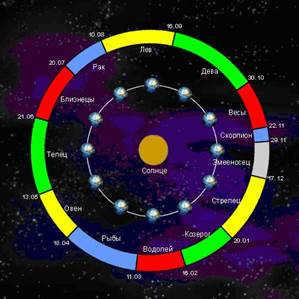
The set of stars that the ecliptic passes through is known as the zodiac.
The zodiac consists of 12 constellations, each representing one month of the year based on the position of the Sun.
Despite the existence of a 13th constellation called Ophiuchus, it is not included in the traditional zodiac.
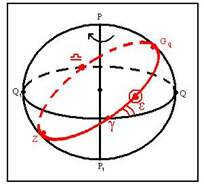
– The vernal equinox point is on March 21 (when the day equals the night).
The Sun’s coordinates are: α ¤ =0 h , δ ¤ =0 о
This designation has been preserved since the time of Hipparchus, when this point was in the constellation of Aries → it is now in the constellation of Pisces, and in 2602 it will move to the constellation of Aquarius.
– The summer solstice day is on June 22 (the longest day and the shortest night).
The Sun’s coordinates: α ¤ =6 h , ¤ =+23 о 26′
This designation has been preserved since the time of Hipparchus, when this point was in the constellation of Gemini, then moved to the constellation of Cancer, and since 1988 it has been in the constellation of Taurus.
– The day of the winter solstice. December 22nd. (the shortest day and the longest night).
The Sun’s coordinates: α ¤ =18 hours , δ ¤ =-23 degrees 26 minutes
During Hipparchus’ time, the point was located in the constellation Capricorn, but now it is in the constellation of Sagittarius, and in 2272 it will move to the constellation of Serpentor.
Let’s select a specific star and fix its position in the sky. In the same location, the star will reappear after 24 hours, or more precisely, after 23 hours and 56 minutes. This time period, when measured with respect to distant stars, is known as a stellar day (to be exact, a sidereal day is the interval between two consecutive upper culminations of the vernal equinox). But where do the additional 4 minutes go? The reason for this is the Earth’s movement around the Sun, causing it to shift by 1° per day for an Earth observer against the backdrop of the stars. In order to “catch up” with this shift, the Earth requires these 4 minutes. Each subsequent night, the stars shift slightly to the west, rising 4 minutes earlier. Over the course of a year, the stars will shift by 24 hours, resulting in the repetition of the starry sky. The entire celestial sphere will complete one revolution in a year, which is a consequence of the Earth’s revolution around the Sun.
Therefore, the Earth completes a full rotation on its axis in 23 hours and 56 minutes. The average solar day is 24 hours, which corresponds to the time it takes for the Earth to complete one revolution around the center of the Sun.
Assignment. § 6; practical tasks.
1. The astronomical definition of “twilight”.
2. The four zones of light and darkness on Earth.
3. Astronomical and calendar seasons.
4. “White Nights” – the depiction of celestial beauty in literature.
5. Light refraction in the Earth’s atmosphere.
Internet resources: http://www.nebulacast.com/2012/04/blog-post_
05.html – Living Universe. What is the ecliptic?
(Capella – α =5 h 17 m , δ =46 o ; Deneb – α =20 h 41 m , δ =45 o 17')
– Arcturus
-Dragon, Cepheus
-(In September, the Sun is in the constellation Virgo, in October it is in Leo, and in November it will pass through Libra and Scorpio).
We used the methodical manual by Kunash M.A. to develop the lesson.
We have an archive of 34 lesson plans on astronomy.
For resources, we used the internet movie “53 expedition” and “Sun, Earth, ecliptic”.
This image, taken in 1994 by the Clementine lunar exploration spacecraft, clearly shows the ecliptic plane. The camera captures the Moon illuminated by Earth on the right, the Sun rising over the dark part of the Moon’s surface, and the planets Saturn, Mars, and Mercury (three dots in the lower left corner).
Ecliptica is the term used to describe the great circle along which the Sun appears to move annually on the celestial sphere. In Latin, the word ecliptica is derived from the word eclipse, meaning “to disappear.” This is because during a solar eclipse, the Sun is obscured by the Moon passing in front of it.
The modern definition of the ecliptic is more precise and refers to the cross-section of the celestial sphere by the plane of the Earth-Moon system’s orbit around the barycenter. In simpler terms, the ecliptic represents the plane in which the Earth rotates around the Sun, also known as Earth’s orbit.
Description
The Moon’s orbit is inclined compared to the ecliptic, and the Earth’s rotation around the center of gravity of the Earth-Moon system, combined with the effects of other planets on the Earth’s orbit, can cause the actual position of the Sun to deviate slightly from the ecliptic. This means that the path of the ecliptic is essentially the path followed by the “average sun”.
The angle between the plane of the ecliptic and the plane of the celestial equator is given by the formula ε = 23°26’21.448″ – 46.8150″t – 0.00059″t² + 0.001813″t³, where t represents the number of Julian centuries that have passed since the beginning of the year 2000. This equation is valid for the current centuries. However, over longer periods of time, the tilt of the ecliptic in relation to the equator varies with a cycle of approximately 40,000 years. Additionally, the inclination of the ecliptic to the equator experiences short-term oscillations with a period of 18.6 years and an amplitude of 18.42″, as well as smaller fluctuations (see Nutation).
The term “ecliptic” is used to describe the observation made since ancient times that solar and lunar eclipses only occur when the Moon is near the points where its orbit intersects with the ecliptic. These points on the celestial sphere are known as lunar nodes, and the cycle of their movement along the ecliptic, which takes about 18 years, is called the Saros or Draconic period. The ecliptic path runs through the zodiacal constellations as well as the constellation of the Serpentine.
The ecliptic plane is the main plane in the ecliptic coordinate system used for celestial measurements.
Astrology and the Significance of the Ecliptic
In the realm of astrology, the ecliptic holds great importance. Various schools of this mystical discipline delve into the interpretation of the positions of celestial bodies within the zodiac signs, specifically focusing on their alignment with the ecliptic [2]. Distances between these celestial bodies are often measured in terms of their ecliptic longitude, emphasizing the concept of “aspects” as resonances between their projected positions along the ecliptic. Therefore, it can be said that astrologers primarily consider the ecliptic points when analyzing the relationships between these celestial bodies.
Ecliptic in literature
In the cycle of stories titled “Stories about Pilot Pirks” by Stanislav Lem, the ecliptic plane is depicted as a restricted area for spacecraft. However, circumstances force pilot Pirks to venture into this forbidden zone. It is during his journey that he unexpectedly encounters a dormant alien spaceship that had been brought to the ecliptic plane by a meteor swarm from outside the system.
Additionally, explore these related resources
Citations
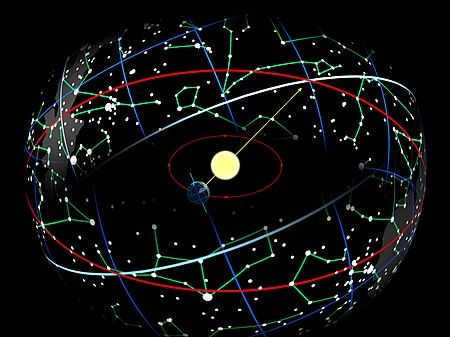
The constellations of the zodiac, also known as the zodiac signs or the zodiacal circle (derived from the Greek word ζωδιακός, meaning “animal”), consist of 12 constellations that lie along the visible yearly path of the Sun along the stars known as the ecliptic. While the Sun does pass through a 13th constellation, the Serpent, it is not traditionally included in the zodiacal constellations.
There is also the concept of the zodiacal belt. This refers to a band in the sky that the Sun, Moon, and planets do not deviate from as they move among the stars.
The zodiacal constellations were reportedly selected as a unique collection during ancient Greece, during the era of Eudoxus of Cnidus. Subsequently, each of these constellations were allocated their own individual sign (refer to Astronomical Signs). Presently, these signs are not employed to identify the specific zodiacal constellations; rather, they are exclusively utilized in astrology to designate conventionally recognized zodiac signs.
Historical Background
During the Hellenistic period, the constellations were used to mark the equinoxes (spring – “Aries”, fall – “Libra”) and solstices (summer – “Cancer”, winter – “Capricorn”). However, over the course of more than 2,000 years, the positions of these points have shifted due to precession. Despite this, the original designations given by ancient astronomers have remained unchanged. Consequently, the zodiac signs, which are linked to the vernal equinox in Western astrology, have also shifted.
The early Russian names of the zodiac constellations, along with their visual representations, can be found in “Izbornik Svyatoslav” (1073). This historical text also includes the names of the seven planets.
The boundaries of the zodiacal constellations were officially established at the Third General Assembly of the International Astronomical Union (IAU) in 1928, where the borders of all 88 modern constellations were approved. However, these borders do not align with the division of the ecliptic into twelve equal parts as accepted in astrology. Therefore, there is no direct correlation between the coordinates of the constellations and the signs of the zodiac. Additionally, the dates when the Sun enters the zodiacal constellations do not align with the corresponding signs of the zodiac. The range of the Sun’s location within the boundaries of the actual constellations can vary from seven days (in the constellation of Scorpio) to a month and sixteen days (in the constellation of Virgo).
Classic geographic designations have been upheld: the Tropic of Cancer (also known as the Northern Tropic), the Tropic of Capricorn (also called the Southern Tropic) – the lines at which the highest point of the summer and winter solstice respectively occur directly overhead.
The constellations of Scorpio and Sagittarius can be seen in their entirety in the southern parts of Russia, while the remaining constellations can be observed throughout the country.
List of constellations in the zodiac
Below is a comprehensive list of constellations that intersect the ecliptic, which encompasses the well-known zodiacal constellations. However, it is important to note that the constellation Serpentine is not classified as one of the zodiacal constellations.
Shining stars
The constellations of the zodiac are home to numerous brilliant stars. Just seven constellations house fifteen of the most prominent ones:
- Aldebaran (α Taurus) – 0.85 magnitude
- Antares (α Scorpius) – 0.96 magnitude
- Spica (α Virgo) – 0.98 magnitude
- Pollux (β Gemini) – 1.14 magnitude
- Regulus (α Leo) – 1.35 magnitude
- Castor (α Gemini) – 1.57 magnitude
- Shaula (λ Scorpio) – 1.63 magnitude
- El-Nat (β Taurus) – 1.65 magnitude
- Kaus Australis (ε Sagittarius) – 1.79 magnitude
- Sargas (θ Scorpio) – 1.86 magnitude
- Alhena (γ Gemini) – 1.93 magnitude
- Hamal (α Aries) – 1.98 magnitude
- Algieba (γ Leo) – 1.98 magnitude
- Nunki (σ Sagittarius) – 2.05 magnitude
- Denebola (β of Leo) – 2.14 magnitude
Notes
- ↑Kondrashov A. P., Strenalyuk Y. V. The latest manual of essential knowledge – M.: RIPOL Classic, 2006. – P. 71.
References
Astronomy Constellations of the Zodiac Astrology
Wikimedia Foundation . 2010 .
Useful
Explore the meaning of “Zodiacal constellations” in different dictionaries:
- ZODIACAL CONSTELLATIONS – The 12 constellations that the Sun passes through during its yearly journey along the ecliptic (see Zodiac and Astronomical Signs) … Large Encyclopedic Dictionary
- zodiacal constellations – The 12 constellations that the Sun passes through during its yearly journey along the ecliptic (see Zodiac and Astronomical Signs). * * * * * ZODIACAL CONSTELLATIONS ZODIACAL CONSTELLATIONS, 12 constellations through which the Sun passes during its annual motion along the… … …Encyclopedic Dictionary
- Zodiacal constellations – The 12 constellations that the Sun passes through each year as it moves along the ecliptic … according to the Astronomical Dictionary
- Constellations of Julius Schiller – In 1627, Julius Schiller, a German astronomer, attempted to completely reform the names of constellations. According to Wikipedia
- Constellations – Star groups that are arbitrarily selected from Earth and do not take into account the actual distances or relationships between the stars. They are remnants of ancient times and are now used in modern astronomy only as a mnemonic aid for dating … as stated in the F.A. Brockhaus and I.A. Ephron Encyclopedic Dictionary
- ZODIACAL SIGNS – The solar path across the sky is divided into twelve parts, representing each month of the year. Each part is associated with a specific zodiac sign. The signs are as follows: Aries (April) is represented by the dove of Venus, Taurus (May) is symbolized by the tripod of Apollo, Gemini (June) is represented by the tortoise of Mercury, Cancer (July) is associated with… … the Dictionary-Reference on Ancient Greece and Rome, focusing on Mythology
- ZODIACAL SIGNS – The solar path across the sky is divided into twelve parts, with each part corresponding to a specific zodiac sign. Here are the signs: Aries (April) is represented by the dove of Venus, Taurus (May) is symbolized by the tripod of Apollo, Gemini (June) is associated with the tortoise of Mercury, Cancer (July) is represented by… … the List of Ancient Greek Names





